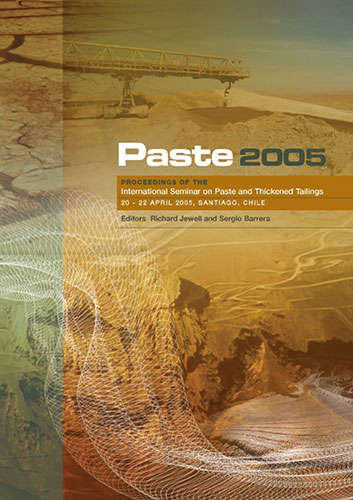The “Lump” Test

|
Authors: Hallbom, DJ Paper is not available for download Contact Us |
DOI https://doi.org/10.36487/ACG_repo/563_5
Cite As:
Hallbom, DJ 2005, 'The “Lump” Test', in R Jewell & S Barrera (eds), Paste 2005: Proceedings of the International Seminar on Paste and Thickened Tailings, Australian Centre for Geomechanics, Perth, pp. 73-97, https://doi.org/10.36487/ACG_repo/563_5
Abstract:
The slump test, a standard test for concrete, has been adopted as a common test for paste and thickened tailings. While the slump test is nominally quantita- tive (i.e., it gives a value for slump in millimetres), it measures a vaguely defined qualitative parameter (“workability”). To make the test more useful for design purposes, it is desirable to relate slump to measurable physical parameters, par- ticularly the slurry density and the apparent yield stress. For laboratory work, the cylinder slump test has been found to be more practical than the cone slump test, mainly due to the smaller test sample size. The Cylinder Model often used to correlate cylinder slump and yield stress has been shown to be consistent with vane test results for moderate to high relative slumps. However, at lower relative slumps the Cylinder Model consistently underestimates the yield stress. This pa- per discusses a variety of concepts relating to the rheological interpretation of the slump test. It also presents a semi-empirical model (the “Lump Model”) that extends the correlation range of the Cylinder Model and is simpler and easier to use. 74 Paste 2005, Santiago, Chile The “Lump” Test Hallbom, D.J.
References:
AS 2701.5:1984, Methods of Sampling and Testing Mortar for Masonry Con-
struction. Method for Determination of Consistency - Slump Test Standards As-
sociation of Australia.
ASTM C143:1996 Standard Test Method for Slump of Hydraulic Cement Con-
crete, Annual Book of ASTM Standards, Vol. 04.02, “Concretes and Aggregates”,
Designation C143-90a.
Balmforth, N.J., Burbridge, A.S., Craster, R.V., Salzig, J., Shen, A. (2000) Visco-plas-
tic models of isothermal lava domes Journal of Fluid Mechanics, 403, pp. 37-65.
Barnes, H.A. (1999) The yield stress – a review or ‘παυτα ρει ’ everything flows
Journal of Non-Newtonian Fluid Mechanics, 81, pp. 133-178.
Barnes, H.A., Nguyen, Q.D. (2001) Rotating vane rheometry – a review Journal
of Non-Newtonian Fluid Mechanics, 98, pp. 1-14.
Baudez, J-C., Chabot, F., Coussot, P. (2002) Rheological interpretation of the
slump test; Applied Rheology, 12, pp. 133-141.
Beer, F.P., Johnston, E.R. (1981) Mechanics of Materials, McGraw-Hill Inc.
Chandler, J.L. (1986) The stacking and solar drying process for disposal of baux-
ite tailings in Jamaica Proceedings of the International Conference on Bauxite
Tailings, Kingston, Jamaica pp. 101-105.
Cheng, D.C-H. (1985) Yield stress: a time-dependent property and how to mea-
sure it British Society of Rheology Conf. on “New Techniques in Experimental
Rheology”, U. of Reading.
Clayton, S., Grice, T.G., Boger, D.V. (2003) Analysis of the slump test for on-site
yield stress measurement of mineral suspensions International Journal of Mineral
Processing 70, pp. 3-21.
Ferraris, C.F. (1999) Measurement of the rheological properties of high perfor-
mance concrete: state of the art report Journal of Research of the National Insti-
tute of Standards and Technology, 104, pp. 461-478.
Ferraris, C.F., de Larrard, F. (1998) Modified slump test to measure rheological
parameters of fresh concrete Cement, Concrete, and Aggregates, CCAGDP, Vol.
20, No. 2, pp. 241-247.
Gawu, S.K.Y, Fourie, A.B. (2004) Assessment of the modified slump test as a
measure of the yield stress of high-density thickened tailings Canadian Geotechnical
Journal, 40, pp. 39-47.
Hallbom, D.J., Klein, B. (2004) Flow Array for Nickel Laterite Slurry Proc. of the
TMS International Nickel Laterite Symposium, pp. 415-428.
Jewell, R.J., Fourie, A.B. and Lord, E.R. (Eds) (2002) Paste and Thickened Tail-
ings – A Guide. Published by the Australian Centre for Geomechanics, University
of Western Australia, UniPrint, 173 p.
Paste 2005, Santiago, Chile 97
Rheology and Thickening
Nguyen, Q.D. (1983) Rheology of concentrated bauxite residue suspensions PhD
thesis, Monash University, Australia.
Pashias, N., Boger, D.V., Summers, J., Glenister, D.J. (1996) A fifty cent rheom-
eter for yield stress measurement Journal of Rheology, 40 (6) pp. 1179-1189.
Paterson, A.J.C. (2002) Is slump a valid measure of the rheological properties of
high concentration paste slurries? Proc. 15th International Conference on
Hydrotransport, Banff, Canada pp. 361-374.
Saak, A.W., Jennings, H.M., Shah, S.P. (2004) A generalized approach for the
determination of yield stress by slump and slump flow Cement and Concrete
Research 34 pp. 363-371.
Schowalter, W.R., Christensen, G. (1998) Toward a rationalization of the slump
test for fresh concrete: Comparisons of calculations and experiments Journal of
Rheology 42 (4) pp. 865-870.
Talbert, S.H., Avitzur, B. (1996) Elementary Mechanics of Plastic Flow in Metal
Forming John Wiley & Sons.
© Copyright 2025, Australian Centre for Geomechanics (ACG), The University of Western Australia. All rights reserved.
View copyright/legal information
Please direct any queries or error reports to repository-acg@uwa.edu.au
View copyright/legal information
Please direct any queries or error reports to repository-acg@uwa.edu.au